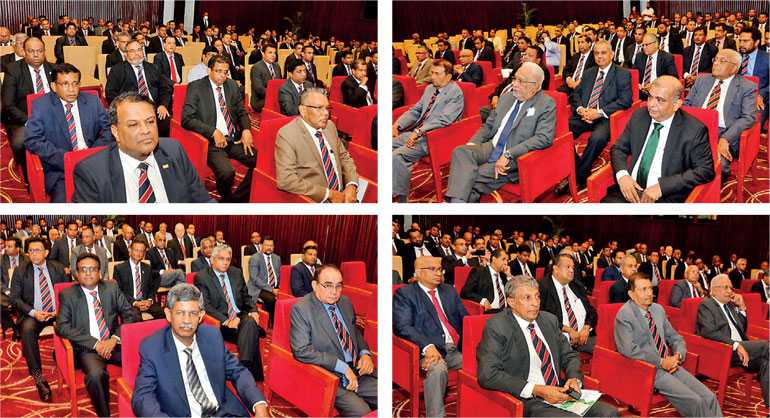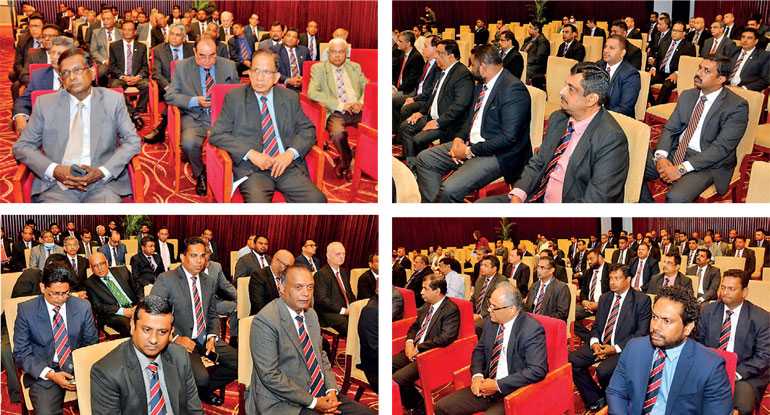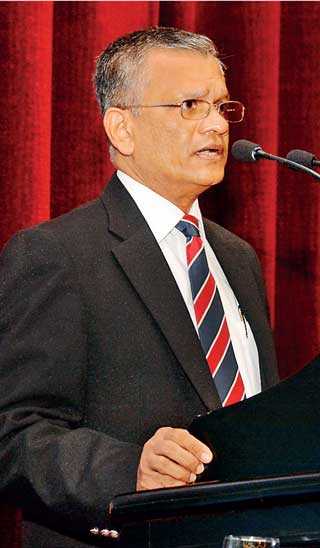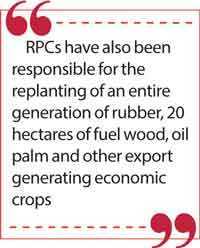Wednesday Jan 07, 2026
Wednesday Jan 07, 2026
Monday, 21 September 2020 00:00 - - {{hitsCtrl.values.hits}}


Outgoing Planters Association Chairman Sunil Poholiyadde briefly revisited developments of significance over the past year at the Association’s Annual General Meeting held on Friday. His speech provides key insights to challenges faced by the plantation industry. Here are excerpts
The entire plantation industry was the only sector in Sri Lanka that was able to continue operations uninterrupted during the pandemic, except for an initial break of three to four days. I wish to take this opportunity to once again thank the
 |
| PA Past Chairman, Sunil Poholiyadde
|
Government and all other stakeholders, including the Trade Unions and particularly, the members of this Association, for taking extraordinary initiative and risk in order to ensure the continuity of the industry at such a critical moment.
As a result of these efforts, ours was the only industry which contributed to the foreign exchange earnings of the country during the initial phase of the pandemic. During this time, there were several measures which we were compelled to take to ensure continuity. One of the most remarkable in this regard was the conversion of tea auctions from the outcry system carried out for over a century into an e-auction, which has since become part of the new normal.
Rubber auctions were also hampered by the pandemic, but they too were able to quickly resume the traditional auction with a break of only 6 weeks. In this, we need to thank the Colombo Rubber Traders’ Association for the initiative taken by them.
I also take this opportunity to thank all the plantation companies and their executives, especially the planting executives and estate staff, for taking all necessary precautions and thereby ensuring that there was no room left for any adverse impact to the industry right from the outset.
We also take pride in the achievements of several of our members in securing SLS certifications for COVID-19 safety management systems and for all RPCs in maintaining strict compliance with all requirements set forth by health authorities.
At this juncture, it is traditional that the Chairman give a brief summary on the performance of individual crops.
Tea
Where the tea industry is concerned, we continued to see a dip in prices which commenced with the glyphosate issue in
2015. With other countries becoming increasingly stringent on certain MRL issues, we have - to a great extent - lost ground in strong and valuable markets, especially in Japan, which in turn has had a negative impact at the auctions.
However, during the latter part of the financial year, there was an improvement in tea auction prices, mainly connected to the disruptions caused by COVID-19, where the production of many countries was restricted.
Demand for tea may have also increased – particularly during the initial phases of the pandemic, partially as a result of the fact that tea is a beverage which has been found to contain properties that science has found to be beneficial to boosting the immune system, which may help prevent the spread of COVID-19.
Where production is concerned, the tea industry in Sri Lanka went through a difficult period with the continuation of the drought conditions. This past year, our industry recorded one of the worst such droughts in the past two decades. This too had the effect of boosting the price – given the resulting supply-demand dynamics.
However, the market has since declined by almost Rs. 100, as compared to prices prevailing in and around April-May. This drop was most acutely felt in the high-grown tea segment, where RPCs account for the majority of production, whilst the low grown leafy teas have appreciated in price. Even currently, there is a difference of almost Rs. 100 in the price between the high-grown western teas against the low-grown leafy teas.
Although there are a lot of misconceptions and misinformation circulating on the topic of replanting, with regard to the RPCs, we are proud to say that since privatisation, it has been RPCs who have replanted 60% of VP tea standing, at
more than twice the rate of replanting undertaken during the same period by tea smallholders. It is also vital to note that this has been accomplished by RPCs without any of the assistance in terms of grants and lower costs which are available to smallholders.
 |
 |
 |
 |
 |
 |
In addition to tea, RPCs have also been responsible for the replanting of an entire generation of rubber, 20 hectares of fuel wood, oil palm, and other export generating economic crops.
Another critical issue where tea is concerned relates to the severe shortage of workers. Today our workforce has reduced by almost 50% in the high-grown tea sector since many of the younger generation does not want to be workers on a plantation. Therefore the only way forward would be for the pursuit of greater mechanisation, which would also help to increase productivity.
Rubber
The national production of rubber keeps declining, mainly due to the poor prices which have continued for over the past 8 years. You may recall that the prices of natural rubber in and around 2012 increased to almost Rs. 600. Unfortunately, these high prices only prevailed for about 2 years, and thereafter declined to almost Rs. 200, which had the effect of
making the industry uneconomical. These dynamics forced many smallholders to stay out of production, however, since the RPCs have a permanent labour cadre, they were forced to offer work and harvest latex in order to keep the workers employed, even though the cost of production is much higher than the sales average at auction.
During my tenure, we should also keep in mind that that there have been 3 wage negotiations. At each instance, the wages increased despite prices remaining essentially static over this period.
Oil palm
The oil palm industry commenced in this country more than 50 years ago. Given the success of these projects, the plantation companies working in close consultation with the Government had chosen oil palm as a third mainstream plantation crop to pursue for diversification. These strategies were consolidated with acceptance by the Government of the need to increase sustainable oil palm cultivation up to 20,000 hectares.
Unfortunately, after having completed almost 11,000 hectares of this expansion, there is now a ban on any further planting or replanting of oil palm. This is again due to numerous misconceptions regarding environmental hazards. On numerous occasions, our association has called on those who oppose oil palm cultivation on such grounds to produce the evidence on which they have made such claims so that we might be able to objectively consider the merits of such claims and take policy decisions that are first and foremost grounded in science. To this day such evidence has not been forthcoming. We can only conclude in this instance that absence of evidence does in fact constitute evidence of absence.
In fact, the companies have invested heavily in this crop and currently, there are currently almost Rs. 300 million worth of plants in company nurseries for which seed materials were imported only after having sought out all relevant approvals from authorities.
Although the plants are now totally overgrown, it would be prudent if - at least at this juncture - a decision could be taken to allow the companies to at least plant what is already in the nurseries so as to recover even a fraction of the
investments made into this crop.
It is also worthwhile considering the fact that due to climate change, most of the rubber growing areas are inundated with historic levels of high rainfall, which results in a drastic reduction in the number of tapping days possible for rubber.
Given these particular circumstances, and the fact that oil palm requires approximately 3,000 ml of rainfall per annum to reach optimal productivity, it is clear that many rubber growing areas are now much better suited for oil palm cultivation. These are trends that will only continue to escalate.
Further there is a huge scarcity of labour in the low country. Given that oil palm requires 50% less workers than a rubber plantation, this is clearly an ideal diversification.
Finally, from an economic perspective, cultivation of sustainable oil palm has already proved invaluable in conserving foreign exchange and minimising outflows, given that Sri Lanka imported an estimated 150,732 metric tonnes of edible oil, at a value of Rs. 16.2 billion in 2019 alone. In fact, plans to expand oil palm cultivation by 20,000 hectares was first arrived at based on consideration of the per capita consumption of edible oil in Sri Lanka and the need to promote import substation in this area.
Way forward
Since privatisation in 1992, the plantation worker wages renegotiated in a collective bargaining process to reach a Collective Agreement every 2 years. This has resulted in a gradual escalation in the wages.
Although the companies saw the necessity and advocated in favour of the establishment of a link between productivity and wages, such a solution had been considered unacceptable to the Trade Unions.
Despite this, we were able to introduce a productivity-linked wage structure 4 years ago. Unfortunately in the last negotiations which took place in 2019 January, and following agitation from the Unions, the productivity link was removed while a 40% increase in the basic wages was granted. This wage applies for two years irrespective of productivity or price.
Further, this wage model applies to all crops in the plantations despite the drastic differences in the revenue generating
capacity of all of the other crops. As a result, where tea is concerned, the price of a kilo of tea which was double the wage in 1992 has increased to be 50% of the wage as at present.
Where rubber is concerned, wages were fixed at a time when rubber was selling at Rs. 600, and they have remained at these levels even though the price of rubber has since collapsed down to Rs. 300.
This is quite evidently an unsustainable position.
Therefore we firmly believe that this wage structure is totally outdated and must urgently be migrated into a productivity-based model which is also linked to price. This would enable productive workers to earn the maximum possible when there is an appreciation in the price, while ensuring that they are duly rewarded for their productivity.
Today the smallholder sector accounts for 75% of the tea and almost 65% of rubber production. We believe the improvement in this sector is mainly due to this structure of payment where the smallholder is paid based on the selling average of the factory - which is to say, price - and the poundage they bring in, which is productivity.
This has been a very successful model and so we believe that the way forward for the industry should be a wage structure that is firmly linked to productivity and price. We also believe that there should be proper policy laid down by the Government based on the covenants of the privatisation agreements, which includes permission for diversification, and the institution of a land policy which specifically prevents lands which RPCs have invested substantially in from being acquired, as has unfortunately been the case over the recent past. Such measures would undoubtedly help to attract more investors and larger, long-term investments into the plantation sector as a whole.
Highlights
I have now come to the final stage before I vacate the Chair. During my tenure in office as Chairman of the Plantation Services there has been growth for over 4 years, and another 4 years as Chairman of the PA. During this period, we have concluded 3 wage negotiations which had been a main task for the industry, and I thank all stakeholders for the cooperation extended in reaching an agreement.
We were also compelled to deal with the sudden ban of glyphosate in 2015 which resulted in tea producers facing immense difficulty in managing their properties, and which also affected auction prices. Following numerous deliberations, the PA has succeeded in getting a temporary lift of the ban until a proper alternative is made available and we are grateful for the co-operation extended to us by all stakeholders in that regard.
Finally, it was the totally unexpected COVID-19 pandemic which I consider the ultimate test for deciding the survival of the fittest, and I’m glad to announce that the Planters’ Association has succeeded in proving themselves as being the fittest industry in the island – given the remarkable mobilisation by all stakeholders to ensure that we were able to continue operating without any prolonged interruptions during such a disruptive moment in history. I thank the Government and all stakeholders in joining with us to ensure the continuity of the industry during the current pandemic.
In concluding, I wish to once again emphasize on the remarkable and unified effort taken by all stakeholders regardless of political or ideological divides in protecting the industry and the plantation community against the COVID-19 pandemic. If there is one lesson that we can all take away from this historic moment, it is that the unprecedented level of cooperation we achieved must serve as the benchmark for how we come together to resolve all other pressing challenges facing our industry at this moment. We must work together to achieve a sustainable future for our industry and all of who are connected to it.
Pix by Upul Abayasekara